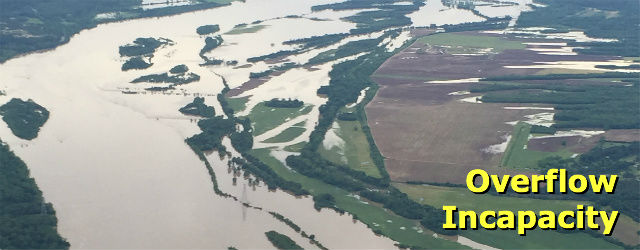Study Begins On Vital River Convergence Area
by July 10, 2015 6:08 am 273 views

The U.S. Army Corps of Engineers’ Little Rock District and the Arkansas Waterways Commission signed a $3 million cost-sharing agreement Thursday to fund a study meant to ensure the Arkansas River remains navigable. Meanwhile, water is currently overtopping one of the structures that makes that navigation possible.
The Three Rivers Study will consider engineering challenges along the convergence of the Arkansas, White, and Mississippi Rivers. Because the bottom of the Arkansas is not navigable, barges bypass that part of the river, instead traveling through a series of locks on the White between the Arkansas and the Mississippi.
A 2009 study found a 7-10% annual chance of a breach between the Arkansas and the White Rivers. Were that to happen, one of several scenarios – the Arkansas and the White overflowing into one another or the Mississippi River shifting – would make navigation impossible as well as negatively affect the local ecosystem.
In the event of a breach, travel along the McClellan-Kerr Arkansas River Navigation System would stop – for more than 100 days, the Corps of Engineers says, while Gene Higginbotham, executive director of the Arkansas Waterways Commission, said it would halt for a year.
Higginbotham said barge traffic on the Arkansas River has a $1.1 billion annual economic impact on Arkansas. The river is a primary transportation corridor for fertilizer in the central United States, and it is an important corridor for other products as well.
The Three Rivers Study is being funded by $1.5 million in federal money through the Corps of Engineers and $1.5 million in state money through the Arkansas Waterways Commission. The Legislature appropriated the money earlier this year.
The study must be completed within three years. The clock started ticking June 30, Higginbotham said.
Higginbotham pointed out that the Three Rivers Study is one of 10 projects designated as a new start feasibility study this year by the Obama administration, meaning it’s a priority for work to begin after the study.
The Corps has spent an average of $1 million a year for at least 20 years creating temporary fixes to problems that arise in the area, said Col. Courtney Paul, Little Rock District commander and district engineer. After flooding in 2011, the Corps spent $12 million over the next two years. Because of recent heavy rains, one of the structures separating the Arkansas and the White, the Melinda Owens structure, is currently overtopped by the Arkansas, though it has not been breached.
“We’re trying to get past the repeated bandage fixes and go to something that’s a little more permanent that still doesn’t disrupt the environment around that area,” Paul said.
